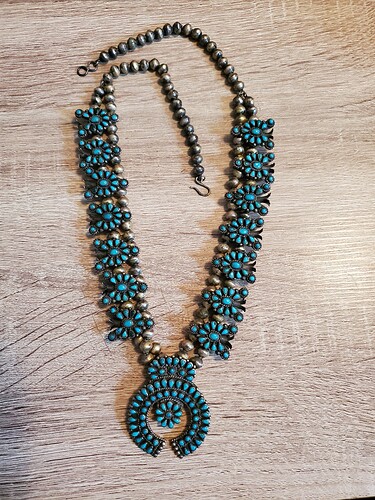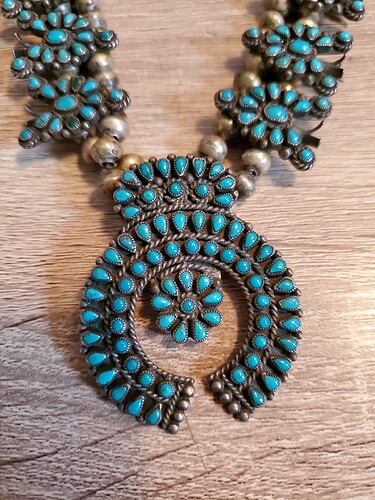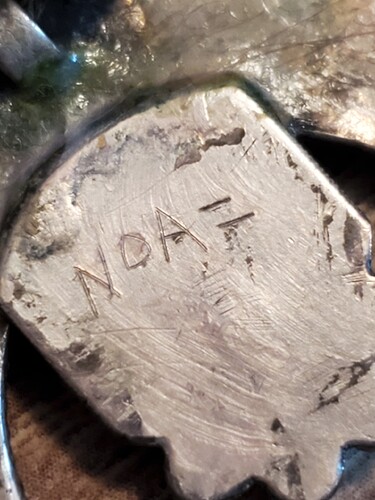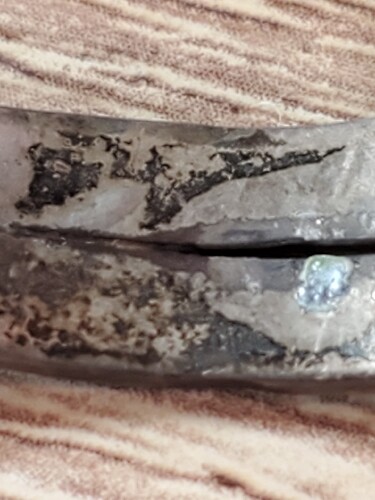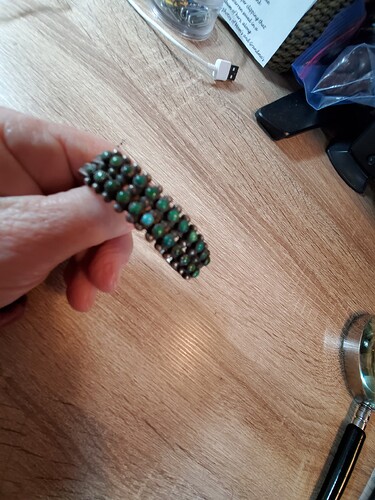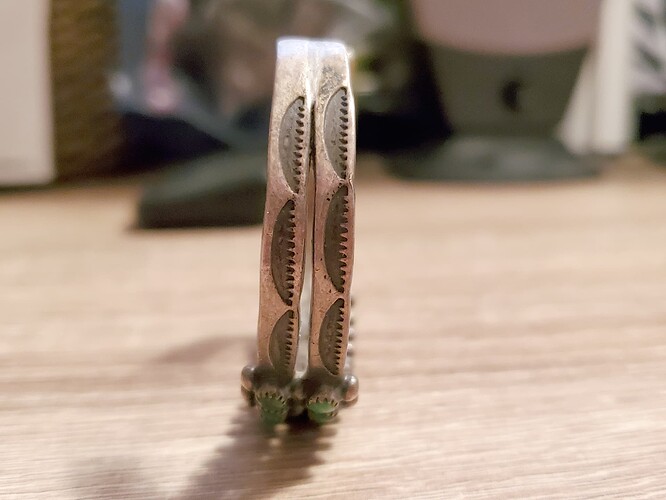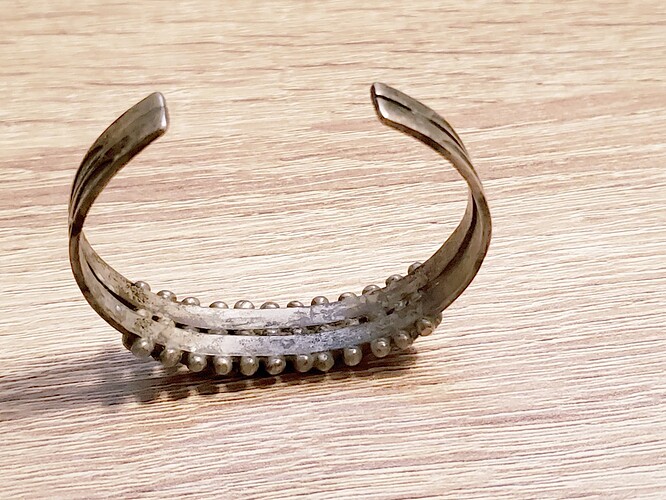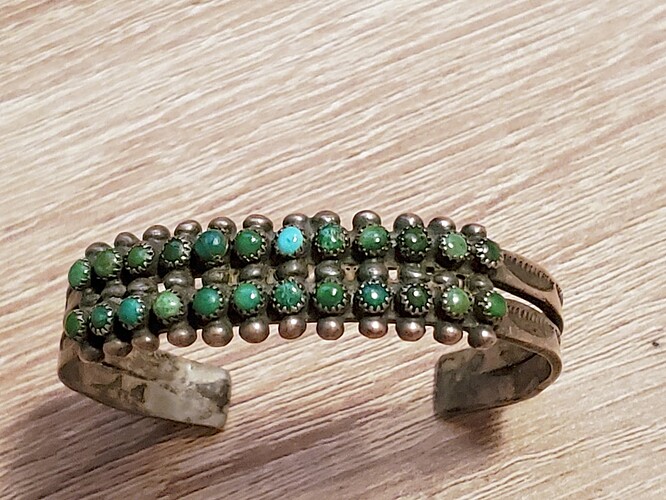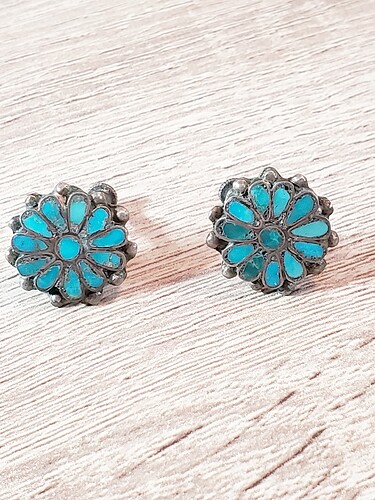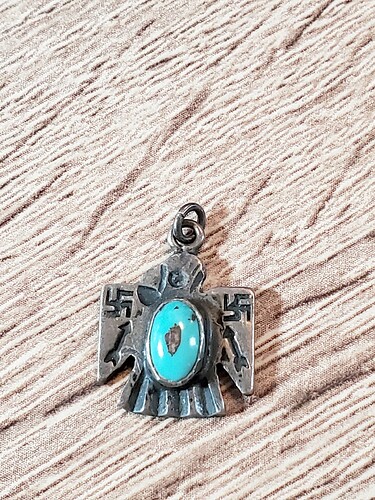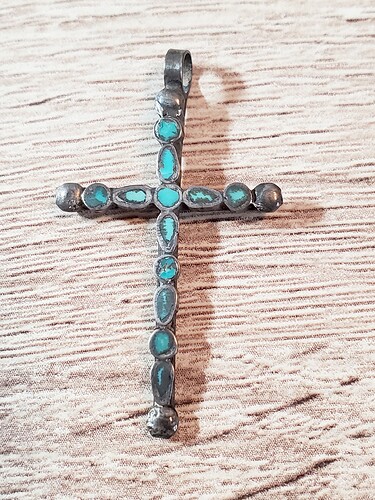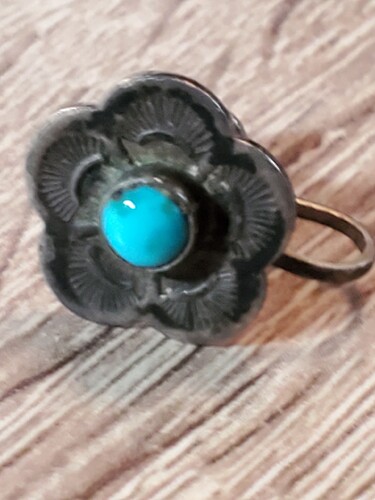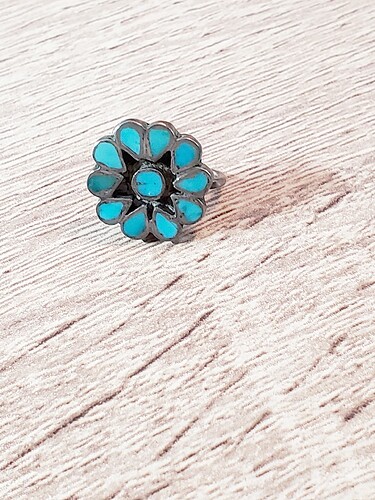Hi all, I have a squash blossom necklace which I inherited from my aunt or grandmother. It is almost certainly Zuni, based on what I have read and the photos I have viewed in various places online. It has some kind of maker’s mark on the reverse of the naja, which is faint. I believe it says NOA with a Z just to the right of those initials and barely lower. I haven’t found anything on other listings that indicates who NOA might be. That is my first question. Secondly, all the photos I have seen of similar necklaces to mine have either 4, 5 or 6 blossoms. Mine has 7 on each side, and I have not found any photo of another one like that with 7 blossoms. Can anyone help me (1) ID who NOA might be, and (2) tell me if having 7 blossoms is normal, or does it make this necklace more special? I will be interested in selling it, but want to acquire as much knowledge as I can before trying to do so. I can add photos if needed. Thanks in advance.
Mary in Los Angeles
Hi Mary, Could you please post photos of the front and back of the piece and clear photos of hallmarks? There are many members on here that could probably help you if they could view the item.
Thanks, TaraFawn. I will do that asap.
Here are three photos of the squash blossom, including the back of the naja. My grandparents and aunt lived in Phoenix, Arizona for many years starting in the early-mid 1920s. I don’t know if this necklace came from early in their residence there, or later.
I also have a cuff bracelet which came to me from them, and I just noticed some kind of maker’s mark on the back, but can’t read it because of the tarnish. I’ve read that I should not polish these pieces. Should I polish only the rear portion where the mark is so that it is more readable?
Very nice squash blossom necklace. Zuni pettipoint style. The markings on the back are probably a code used by a pawn shop that either they use to know the price paid or an inventory number. Jason, can give you an idea of value and maybe the age.
Really nice set. I’m not as familiar with Zuni but as Markyboy said @Jason can probably give you some more information.
Thanks, people. I’ll hope to hear from Jason when he has time.
This is a lovely squash blossom. It’s an older one, my guess would be 1940’s or 50’s. The turquoise is natural (not stabilized), which you can tell because it shows some color change. The silver beads look to be fully hand made, which is a feature of earlier Zuni squashes. It does have a lot of blossoms per side, which means more turquoise as well as the work that goes into making each blossom, so that is a nice feature. The initials NOA are likely a traders code or the initials of a previous owner that they etched into it, not a makers mark. Hallmarking Zuni jewelry didn’t become common until the 60’s or even the 70’s. I would say 2.5-3.5k for the necklace (gallery retail, it may be hard for you to realize that much selling it). Also, it looks like the two rows of beads are twisted to the left of the naja? It might need to be restrung in order to lay correctly.
The pictures of the bracelet aren’t great; it’s a little hard to tell much from them. I’m not seeing a makers mark in the pic you posted of the back, though. This style of snake eye row bracelet was a popular Zuni style that was widely imitated by makers of machine made tourist jewelry. The tourist pieces often used compressed turquoise powder in place of real turquoise. Yours looks to possibly be the real deal, Zuni handmade with real turquoise, but I can’t tell for sure from your pics. Again, it would be unusual for a Zuni bracelet of this age to be hallmarked.
Beautiful Squash. Could you post pics of the sides of the cuff? It has a Fred Harvey look to it. I have a 1920’s Harvey single row cuff that reminds me of yours, from the front anyway. My cuff has natural turquoise which has changed color over the decades. The stones in yours also look to have done that.


 It’s absolutely gorgeous!
It’s absolutely gorgeous!
OK, here goes. First photo is side of the cuff of the bracelet, and better photos of the front and inside. The bracelet is 2-1/4" at its widest part and a 1/2" wide cuff in the middle where the stones are. A bit small, but it just barely fits my wrist.
Then, if I’m not being presumptuous of your time, I’m also posting photos of the other small pieces I have from the same family source. A pair of screw-on earrings that are 1/2" diameter:
Above is a small thunderbird necklace pendant that measures 1/2" wide x 5/8" tall. I can’t tell if the mark in the middle of the stone is a flaw, a scratch, or if it is natural. It does feel just a little rough as I run my fingernail across it.
I will now have to do another separate post, since as a new member I am only allowed 5 uploads at a time. To be continued in a minute…
Part II, continued from above.
A cross measuring 1-1/4" not counting the ring at the top for threading onto a chain.
Two single screw-back earrings that lost their partners somewhere along the way. I was thinking of possibly having one or both of them converted to necklace pendants, since my birthstone is Turquoise (December). In that event, since one of those earrings is very similar to the pair in the message above, I could have that pair converted to stud backed for pierced ears. Not sure yet.
Thank you all for the input you have already given me, and thanks in advance for any info you can provide about provenance or possible worth. If you can possibly recommend the best way for me to offer these for sale, I would love to hear that. I hate eBay and would much rather sell to a collector directly or to a store which specializes in this type of jewelry. All of these pieces came to me from my Aunt, as I mentioned in the earlier posts.
Thank you so very much.
Mary
good morning Mary, are there any markings on the backs of the earrings or the cross?
that type of inlay is known as “Dishta” and you may have some originals there.
Frank Dishta jewelry <link
Does anyone else think the cuff (and thunderbird pendant) look like Fred Harvey? I don’t know what they run price wise now, but I paid around 130 for mine back in 2005 in an antique store in ABQ, and mine only has one row of stones. I’m sure you can find a lot online regarding Harvey pieces.
You can definitely get the earrings converted! I did that with a small belt buckle and love it.
I hate the term Fred Harvey, because I think it can be confusing and doesn’t specify between machine made jewelry, machine made hand finished, and Native made jewelry that was marketed to tourists utilizing thinner silver and lots of stamping. Additionally, some people use it to refer to a style, and others to a time period (Fred Harvey Era). Or they say Fred Harvey Era when they actually mean style. The Fred Harvey era was a fairly long period, from about 1900 to 1960, so saying jewelry is from that era doesn’t point to a very specific time period. Plus lots of jewelry that doesn’t fit the Harvey style was made in that era. I prefer the terms tourist style or railroad style jewelry, which I think are clearer in that they refer to the jewelry that was specifically marketed to tourists traveling the Southwest by railroad. That jewelry generally was more lightweight, featured a lot of sheet silver and stamping, and symbols that fit what tourists thought of as “Indian” but didn’t necessarily have any history or meanings in Native culture. It could be hand made by Natives, but was also machine pressed, which is an important distinction.
The thunderbird pendant is a machine pressed tourist pendant, what a lot of people would refer to as Fred Harvey jewelry. It has real (probably natural) turquoise and the spot in the middle is just some matrix. The bracelet is a style that was hand made by Zuni, but also widely imitated by sellers of machine made tourist jewelry. So in my post above I was basically saying I couldn’t tell if it was a Zuni bracelet, or a machine made tourist (Harvey) bracelet. I’m still a little confused, because based on the additional pictures the silverwork and stamping appears to be hand done but I still think the stones look like they could be compressed turquoise. Open to other people’s opinions on the bracelet.
I’m assuming you mean you hate the term Fred Harvey because it’s so often misused, like I hate the term old pawn when there’s no proof that things are either old nor pawn. However, I meant the term literally. The piece I have is most definitely a Fred Harvey tourism piece, and that’s why I bought it because I wanted a piece of that history (and I bought it from a very knowledgeable elderly gentleman with an antique Native and Western Art store). Hers reminds me of mine a bit. The sides on hers are definitely a deeper stamping; is that why you thought it might be hand done? Mine are more faded, but it’s old (and I do trust the seller). Also I’m curious as to what made you think the stones are possibly composite? I have read that some of literal Fred Harvey pieces did use cerillos (hmmm not sure I spelled that right) turquoise. I believe the stones in mine are natural (probably low grade) due to what the seller told me, and they do have a slightly different look than hers. Can’t quite put my finger on it. I am not doubting you, I just want to learn! You are very knowledgeable, and I appreciate learning from you.
And I should have been more clear in my earlier post in saying that that didn’t mean I thought I was most definitely right, just had some input.
Hate is probably a strong word. I dislike the term because it’s not clear to me exactly what people mean when they say it, and I think sometimes different people mean different things by it. What do you mean when you say that your bracelet is literally a Fred Harvey tourism piece? That it was actually sold by the Fred Harvey company? That it was marketed to tourists? That it was machine pressed? You may mean the same thing that I mean when I say tourist or railroad style jewelry—lightweight silver with lots of stamping and designs like thunderbird, crossed arrows, and whirling logs that was marketed to tourists between about 1900-1960. The jewelry that I consider tourist jewelry can be machine or man made, Native made or not (but more often not, or they just hired Natives to operate the machines and then marketed it as Indian made).
I’m actually leaning toward the bracelet MaryL posted as being real turquoise, but the stones look slightly grainy. However not all of them look grainy, and they’re showing nice color change. But a granular appearance is typical of the compressed powder turquoise. The picture isn’t quite close up and focused enough that I can tell for sure. As far as the stamping, hand stamps will have imperfections in their uniformity, depth, how they were struck, the spacing, ect. The machine made pieces will have “stamped” designs as part of the pressing and they will be very uniform.
I didn’t mean to pick on you for using that term; it’s a very common term and I think I’m in the minority in not liking it. I just find it a little confusing and actually didn’t know what you meant when you asked if the bracelet and pendant were Fred Harvey. Also, the old tourist style pieces are very collectible and popular, even those that are machine pressed.
Thank you, that all makes sense to me now. I didn’t really understand that people used the term Fred Harvey as descriptive of a style without saying so (guess I should have figured that). I assumed it meant literally made for Fred Harvey Company gift shops. I had always wanted a Fred Harvey piece because when I was young we had stayed at Harvey hotels and I loved the history. The gentleman I bought it from said that was the case with my cuff, and wrote it down on the receipt. He had a reputable store in ABQ that dealt in antique and older art. I’m assuming he passed away (he appeared to be in his 80’s back in 2005), and the store is closed, which makes me sad. We often stopped there. He was another of those priceless gracious traders who taught me so much.
I see what you mean on the turquoise; I think that was what I was trying to put into words. It’s hard to tell from the picture, but the stones in mine look different. The stamping on hers looks more firm (not sure that’s the right word); on mine it’s uneven in some places, but I didn’t know if that came from age.
Thanks again for the info. Now I know to specify better regarding Fred Harvey what I mean.
I had this conversation with Bob Bauver and he too takes exception to Fred Harvey era/Fred Harvey style as terms used for Navajo commercially sold jewelry in the early decades of the 20th c. For him it’s misleading as a catchall phrase, because there was Navajo work, handmade but for the marketplace, entirely independent from the Harvey world of distribution. And we know that early traders themselves cooked up styles for sale, advertised in catalogues.
This shows how clueless I can be. I don’t believe I’d really ever heard the term “Fred Harvey style” used until I was on this forum. I just always thought people literally meant it was made for the Fred Harvey company. But then I’d never seen “old pawn” used much outside of actual old pawn jewelry (with tickets) for sale. Probably because I rarely looked at jewelry on the internet, and when I shopped out west it was usually in trading posts or older stores. My naivety (I think I just made that word up) bubble has been burst 
